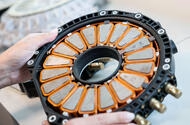How did Yasa Motors achieve a world record for electric motor power density?
Yasa Motors, a UK-based company owned by Mercedes-Benz, has just shaken up the electric motor landscape with a prototype that’s turning heads for all the right reasons. Their latest creation weighs in at just 13.1kg but packs a staggering 738bhp punch. To put that in perspective, that’s 56bhp per kilogram—more than double the current industry benchmark of 20bhp per kg. Even the Equipmake HPM-400, a leader in aerospace and marine applications, delivers 54bhp per kg. Yasa’s achievement isn’t just a marginal improvement; it’s a leap that redefines what’s possible in electric motor design.
What’s behind this breakthrough? Surprisingly, it’s not exotic materials or bleeding-edge 3D printing. Yasa’s CTO and founder, Tim Woolmer, emphasizes that the motor was built using standard materials and conventional manufacturing methods. No cobalt-iron laminations, no litz wire, and no experimental processes. This means the technology isn’t just a lab curiosity—it’s ready to scale, and that’s a game-changer for the automotive world.
Why does power density matter for electric vehicles?
If you’ve ever wondered why electric supercars and high-performance EVs are still relatively rare, power density is a big part of the answer. The higher the power-to-weight ratio, the more performance you can squeeze out of a smaller, lighter package. That translates to better acceleration, sharper handling, and—crucially—more space and weight savings for batteries, passengers, or cargo.
For automakers, a lightweight, high-output motor opens up new possibilities. Imagine a sports car that’s not only blisteringly fast but also has a longer range because the motor itself is so efficient and compact. Or picture luxury EVs that don’t have to compromise on interior space to accommodate bulky drivetrains. Yasa’s new motor could be the key to unlocking these next-gen designs.
How does Yasa’s innovation compare to current industry leaders?
Let’s look at the numbers. The Equipmake HPM-400, widely used in aerospace and marine vehicles, weighs 40kg and produces 54bhp per kg. That’s impressive, but Yasa’s prototype edges ahead at 56bhp per kg, and it does so at less than a third of the weight. What’s more, Yasa’s approach is refreshingly practical. By avoiding rare or expensive materials, they’re sidestepping the supply chain headaches that often plague high-tech manufacturing.
This isn’t just about bragging rights. The ability to mass-produce such motors—Yasa claims up to 50,000 units per year at their Oxfordshire plant—means the technology could be widely adopted, not just reserved for hypercars or concept vehicles. That’s a big deal for the broader EV market.
What does this mean for the future of electric sports cars and supercars?
Yasa already counts Lamborghini, Mercedes-AMG, and Ferrari among its clients, so it’s a safe bet that this motor—or its successors—will find its way into some seriously exciting vehicles. While the company hasn’t announced which models will get the new motor or when production versions will be available, the implications are clear. We’re on the cusp of a new era where electric sports cars can deliver the kind of visceral performance and driving excitement that enthusiasts crave, without the weight penalties that have traditionally held EVs back.
And it’s not just about speed. Lighter, more efficient motors mean better handling, improved energy efficiency, and potentially lower costs as manufacturing scales up. For automakers, this could be the missing piece in the puzzle to make electric sports cars truly mainstream.
Are there any challenges or limitations to this technology?
Every breakthrough comes with its own set of hurdles. While Yasa’s prototype numbers are impressive, the real test will be in scaling up production and maintaining performance and reliability in the real world. Automotive-grade durability, thermal management, and integration with complex vehicle systems are non-trivial challenges. However, the fact that Yasa’s design avoids exotic materials and experimental processes bodes well for its manufacturability and cost-effectiveness.
Another question is how quickly this technology can be adopted by mainstream automakers. High-end brands like Ferrari and Lamborghini may be first in line, but as production ramps up and costs come down, there’s potential for broader adoption across the industry.
What’s the big takeaway for drivers and enthusiasts?
Yasa’s record-setting motor isn’t just a technical marvel—it’s a sign of where the EV world is headed. We’re moving past the era where electric cars had to compromise on performance or practicality. Instead, innovations like this are making it possible for automakers to deliver vehicles that are lighter, faster, and more efficient, all without relying on rare materials or unproven manufacturing techniques.
The big takeaway? Next-level electric performance isn’t about perfection—it’s about smarter adjustments. Start with one change this week, and you’ll likely spot the difference by month’s end. Whether you’re a car enthusiast, an engineer, or just someone curious about the future of mobility, keep an eye on this space. The electric revolution is picking up speed, and breakthroughs like Yasa’s are leading the charge.

